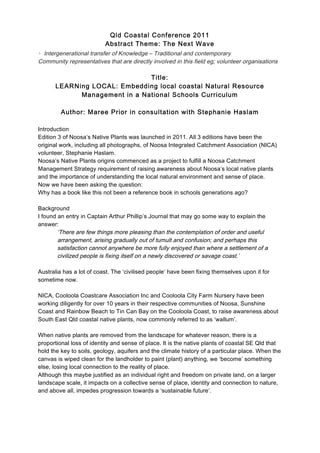Report
Share
Download to read offline

Recommended
Recommended
Author: John Fitzgerald and Chris Giles
(03-42)Embracing cultural diversity within Surf Life Saving Australia

Embracing cultural diversity within Surf Life Saving AustraliaILS - International Life Saving Federation
More Related Content
What's hot
What's hot (8)
Rulers Bar/Blackwall island update 10 29 15 Elizabeth Manclarke-ALS

Rulers Bar/Blackwall island update 10 29 15 Elizabeth Manclarke-ALS
Similar to Abstract-community presentation
Author: John Fitzgerald and Chris Giles
(03-42)Embracing cultural diversity within Surf Life Saving Australia

Embracing cultural diversity within Surf Life Saving AustraliaILS - International Life Saving Federation
Similar to Abstract-community presentation (20)
Embracing cultural diversity within Surf Life Saving Australia

Embracing cultural diversity within Surf Life Saving Australia
VFCPWGIFSJuly102013Meeting-IndigenousFoodSovereignty

VFCPWGIFSJuly102013Meeting-IndigenousFoodSovereignty
Cross Connections: Linking Art, Science and Identity, ANU School of Music

Cross Connections: Linking Art, Science and Identity, ANU School of Music
Indigenous land management in urban and peri-urban landscapes

Indigenous land management in urban and peri-urban landscapes
Recultivating intergenerational resilience through disruptive pedagogies of d...

Recultivating intergenerational resilience through disruptive pedagogies of d...
Recultivating intergenerational resilience through disruptive pedagogies of d...

Recultivating intergenerational resilience through disruptive pedagogies of d...
Abstract-community presentation
- 1. Qld Coastal Conference 2011 Abstract Theme: The Next Wave ◦ Intergenerational transfer of Knowledge – Traditional and contemporary Community representatives that are directly involved in this field eg; volunteer organisations Title: LEARNing LOCAL: Embedding local coastal Natural Resource Management in a National Schools Curriculum Author: Maree Prior in consultation with Stephanie Haslam Introduction Edition 3 of Noosa’s Native Plants was launched in 2011. All 3 editions have been the original work, including all photographs, of Noosa Integrated Catchment Association (NICA) volunteer, Stephanie Haslam. Noosa’s Native Plants origins commenced as a project to fulfill a Noosa Catchment Management Strategy requirement of raising awareness about Noosa’s local native plants and the importance of understanding the local natural environment and sense of place. Now we have been asking the question: Why has a book like this not been a reference book in schools generations ago? Background I found an entry in Captain Arthur Phillip’s Journal that may go some way to explain the answer: ‘There are few things more pleasing than the contemplation of order and useful arrangement, arising gradually out of tumult and confusion; and perhaps this satisfaction cannot anywhere be more fully enjoyed than where a settlement of a civilized people is fixing itself on a newly discovered or savage coast.’ Australia has a lot of coast. The ‘civilised people’ have been fixing themselves upon it for sometime now. NICA, Cooloola Coastcare Association Inc and Cooloola City Farm Nursery have been working diligently for over 10 years in their respective communities of Noosa, Sunshine Coast and Rainbow Beach to Tin Can Bay on the Cooloola Coast, to raise awareness about South East Qld coastal native plants, now commonly referred to as ‘wallum’. When native plants are removed from the landscape for whatever reason, there is a proportional loss of identity and sense of place. It is the native plants of coastal SE Qld that hold the key to soils, geology, aquifers and the climate history of a particular place. When the canvas is wiped clean for the landholder to paint (plant) anything, we ‘become’ something else, losing local connection to the reality of place. Although this maybe justified as an individual right and freedom on private land, on a larger landscape scale, it impacts on a collective sense of place, identity and connection to nature, and above all, impedes progression towards a ‘sustainable future’.